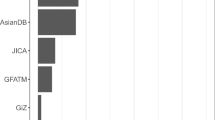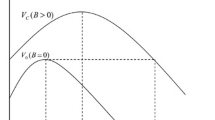Abstract
This article applies a two-tiered contribution model to ascertain the determinants of donors’ participation and contribution levels to giving aid for controlling HIV/AIDS in Africa. Bayesian spatial estimates for the two-tiered model are presented for 22 donor countries that gave aid to 48 recipient countries during 2000–2007. We account for the public nature of HIV/AIDS contributions by including the contributions of other donors as a determinant at both participation and expenditure stages, along with standard determinants of general assistance. Independent variables account for altruistic, political, economic, location, institutional, and environmental factors. Donor’s reaction to spillovers differs in the two stages, thereby supporting the two-tiered estimates over the single-stage Tobit estimates. Aid for AIDS in Africa is motivated by a complex mix of strategic (publicness), altruistic, and donor self-interests. Key factors at both stages include donors’ spillovers, rule of law, past colonial ties, sharing a common language, trade, and people living with HIV. A host of robustness tests are presented.
Similar content being viewed by others
References
Alesina A, Dollar D: Who gives foreign aid to whom and why?. J Econ Growth 5, 33–63 (2000)
Anselin L, Bera AK: Spatial dependence in linear regression models with an introduction to spatial econometrics. In: Ullah, A, Giles, DEA (eds) Handbook of applied economic statistics, pp. 237–289. Marcel Dekker, New York (1998)
Bella E, Reinhardt GY: Giving and receiving foreign aid: does conflict count?. World Dev 35, 2566–2585 (2008)
Beron K, Vijverberg WPM: Probit in a spatial context: a Monte Carlo analysis. In: Anselin, L, Florax, RJGM, Rey, SJ (eds) Advances in spatial econometrics: methodology, tools and applications, pp. 169–195. Springer, Berlin (2004)
Berthélemy J-C: Bilateral donors’ interest vs. recipients’ development motives in aid allocation: do all donors behave the same?. Rev Dev Econ 10, 179–194 (2006)
Berthélemy J-C, Beuran M, Maurel M: Aid and migration: substitutes or complements?. World Dev 37, 1589–1599 (2009)
Chai S-K: Endogenous ideology formation and economic policy in former colonies. Econ Dev Cult Change 46, 263–290 (1998)
Collier P, Dollar D: Aid allocation and poverty reduction. Eur Econ Rev 46, 1475–1500 (2002)
Collier P, Elliott VL, Hegre H, Hoeffler A, Reynal-Querol M, Sambanis N: Breaking the conflict trap: civil war and development policy. World Bank/Oxford University Press, Washington, DC (2003)
Cornes R, Sandler T: Easy riders, joint production, and public goods. Econ J 94, 580–598 (1984)
Cornes R, Sandler T: The theory of externalities, public goods, and club goods. Cambridge University Press, Cambridge (1996)
Correlates of War 2 Project (n.d.) Colonial/dependency contiguity data, 1816–2002. Version 3.0. http://correlatesofwar.org. Accessed 5 January 2009
Cragg JG: Some statistical models for limited dependent variables with application to the demand for durable goods. Econometrica 39, 829–844 (1971)
Dollar D, Levin V (2005) Sowing and reaping: institutional quality and project outcomes in developing countries. World Bank Policy Research Working Paper 3524. World Bank, Washington, DC
Dollar D, Levin V: The increasing selectivity of foreign aid 1984–2003. World Dev 34, 2034–2046 (2006)
Duan N, Manning WG Jr, Morris CN, Newhouse JP: A comparison of alternative models for the demand for medical care. J Bus Econ Stat 1, 115–126 (1983)
Duan N, Manning WG Jr, Morris CN, Newhouse JP: Choosing between the sample-selection model and the multi-part model. J Bus Econ Stat 2, 283–289 (1984)
Eurostat (n.d.) External trade statistics. http://ec.europa.eu/eurostat. Accessed 29 January 2009
Freedom House (2008) Freedom in the world country ratings, 1972–2007. http://www.freedomhouse.org/template.cfm?page=439. Accessed 29 December 2008
Ghobarah HA, Huth P, Russett B: Civil wars kill and maim people—long after the war stops. Am Polit Sci Rev 97, 189–202 (2003)
Gleditsch NP, Wallensteen P, Eriksson M, Sollenberg M, Strand H (2002) Armed conflict 1946–2001: a new dataset. J Peace Res 39:615–637. UCDP/PRIO Armed conflicts dataset version 4-2008, UCDP/PRIO intrastate conflict onset dataset, 1946–2007. http://www.prio.no/CSCW/Datasets/Armed-Conflict/UCDP-PRIO/. Accessed 31 January 2009
Greene W: The behaviour of the maximum likelihood estimator of limited dependent variable models in the presence of fixed effects. Econom J 7, 98–119 (2004)
International Monetary Fund (IMF) (2008a) International financial statistics (IFS). http://www.imfstatistics.org. Accessed 13 January 2009
International Monetary Fund (IMF) (2008b) Direction of trade statistics (DOTS). http://www.imfstatistics.org. Accessed 20 August 2008
International Monetary Fund (IMF) (2009) World economic outlook (WEO) database, April. http://www.imf.org. Accessed 7 August 2009
Jayaraman R, Kanbur R: International public goods and the case for foreign aid. In: Kaul, I, Grunberg, I, Stern, MA (eds) Global public goods: international cooperation in the 21st century, pp. 418–435. Oxford University Press, New York (1999)
Joint United Nations Programme on HIV/AIDS (2008) 2008 Report on the global AIDS epidemic. http://www.unaids.org/en/KnowledgeCentre/HIVData/GlobalReport/2008/2008_Global_report.asp. Accessed 8 December 2008
Kanbur R, Sandler T, Morrison K (1999) The future of development assistance: common pools and international public goods. Policy Essay No. 25. Overseas Development Council, Washington, DC
Kaufmann D, Kraay A, Mastruzzi M (2008) Governance matters VII: aggregate and individual governance indicators, 1996–2007. World Bank Policy Research Working Paper 4654. World Bank, Washington, DC
Lahiri S, Raimondos-Møller P: Lobbying by ethnic groups and aid allocation. Econ J 110, 62–79 (2000)
LeSage JP: Bayesian estimation of spatial autoregressive models. Int Reg Sci Rev 20, 113–129 (1997)
LeSage JP (2009) Econometrics toolbox. MATLAB programs and documentation. http://www.spatial-econometrics.com. Accessed 20 June 2010
LeSage JP, Pace RK: Introduction to spatial econometrics. Chapman and Hall/CRC, Boca Raton (2009)
Manning WG, Blumberg L, Moulton LH: The demand for alcohol: the differential response to price. J Health Econ 14, 123–148 (1995)
Mayer T, Zignago S (2006) Notes on CEPII’s distances measures. The CEPII, Paris. CEPII’s distances dataset. http://www.cepii.fr/anglaisgraph/bdd/distances.htm. Accessed 15 January 2009
McDonald S, Roberts J: AIDS and economic growth: a human capital approach. J Dev Econ 80, 228–250 (2006)
Mishra P, Newhouse D: Does health aid matter?. J Health Econ 28, 855–872 (2009)
Murdoch JC, Sandler T, Vijverberg WPM: The participation decision versus the level of participation in an environmental treaty: a spatial probit analysis. J Public Econ 87, 337–362 (2003)
Neumayer E: Do human rights matter in bilateral aid allocation? A quantitative analysis of 21 donor countries. Soc Sci Q 84, 650–666 (2003)
Nunnenkamp P, Öhler H (2010) Throwing foreign aid at HIV/AIDS in developing countries: missing the target. Kiel Working Paper No. 1642. Kiel Institute for the World Economy, Kiel
Organization of Economic Cooperation and Development (OECD) (2008) Creditor Reporting System (CRS) aid activity database. http://stats.oecd.org/. Accessed 18 December 2008
Organization of Economic Cooperation and Development (OECD) (n.d.) Database on immigrants in OECD countries (DIOC). http://stats.oecd.org/. Accessed 17 June 2010
Posnett J, Sandler T: Demand for charity donations in private non-profit markets: the case of the UK. J Public Econ 40, 187–200 (1989)
Price GN: Economic growth in a cross-section of nonindustrial countries: does colonial heritage matter for Africa?. Rev Dev Econ 7, 478–495 (2003)
Sandler T, Arce DG: A conceptual framework for understanding global and transnational public goods for health. Fiscal Stud 23, 195–222 (2002)
Sonntag D: AIDS and aid: a public good approach. Springer, New York (2010)
United Nations Commodity Trade (UN Comtrade) (2006, 2007) International trade statistics yearbook. http://comtrade.un.org/pb/. Accessed 13 January 2009
Wooldridge JM: Econometric analysis of cross section and panel data, 2nd edn. The MIT Press, Cambridge (2010)
World Bank (2008) World development indicators (WDI). http://data.worldbank.org/. Accessed 14 January 2009
Author information
Authors and Affiliations
Corresponding author
Rights and permissions
About this article
Cite this article
Gaibulloev, K., Sandler, T. Aid for AIDS in Africa. Empir Econ 43, 1171–1197 (2012). https://doi.org/10.1007/s00181-011-0527-3
Received:
Accepted:
Published:
Issue Date:
DOI: https://doi.org/10.1007/s00181-011-0527-3
Keywords
- HIV/AIDS
- Foreign aid
- Bayesian spatial estimates
- Public good spillovers
- Two-tiered contributions
- Donor country




